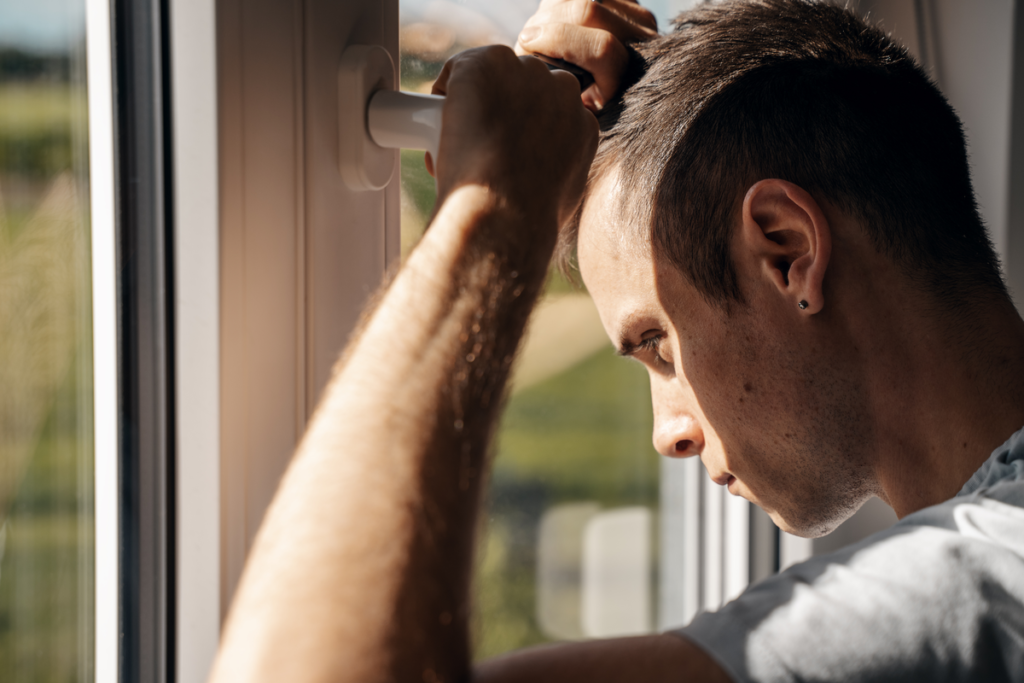Manorexia: An Eating Disorder That Affects Men

Anorexia is an eating disorder (ED) that, in general, affects mainly young women. However, it can also appear in men of different ages. The term manorexia is used to talk about anorexia suffered by men.
Manorexia is considered an unspecified eating disorder. It’s been given this name because gender stereotyping has led us to believe that anorexia is an exclusive disease of women.
Some specialists believe that it’s unnecessary to create new names for differentiating the characteristics of a disorder based on gender. However, manorexia is a term that’s become popular in recent years that allows us to understand the peculiarities of male anorexia.
In this article, we mention the causes and possible origins of manorexia, its most relevant characteristics, and the importance of the therapeutic approach in treating this disorder.
The causes of manorexia
In the first place, social pressure to have a body that fits the hegemonic standards of beauty is a recurring cause in cases of manorexia. This tends to be because advertising, the media, and, above all, social media have generated a series of aspirational models that penetrate the self-esteem of younger people.
These models often influence the construction of body image and the adoption of certain lifestyles. Consequently, constant exposure to such standardized patterns of beauty can make people vulnerable to these types of eating disorders.
In the case of manorexia, dominant masculinity models, which tend to emphasize traits such as physical strength, agility and competitiveness, maybe behind the origin of the disorder. As a matter of fact, the characteristic pattern of manorexia isn’t extreme thinness, but the cultivation of a slim and, at the same time, athletic figure. Sufferers obtain this through the obsessive combination of dietary restrictions and excessive exercise.
Finally, some factors that may be associated with the appearance of manorexia include exposure to a traumatic event, episodes of school failure, or bullying linked to body size. Additionally, parents’ lack of concern along with too little attention to the feeding patterns of their children can be elements that aggravate the situation.
Characteristics of manorexia
In general, those who suffer from manorexia are men, particularly young men, who are afraid of gaining weight. With that idea in mind, they engage in excessive physical activity and eating patterns that can become dangerously restrictive.
Some characteristics of manorexia are as follows:
Food restrictions
Men with manorexia tend to progressively lose their appetite and follow extremely restrictive diets. In addition to this, they may consume laxatives and different types of weight loss supplements.
Excessive physical activity
Perhaps the most common feature is excessive physical exercise, both in terms of hours and effort. They tend to give priority to cardiovascular exercises to burn body fat.
Body image distortion
Similarly, another characteristic sign of this type of eating disorder is the distorted perception of body image. In other words, a man with manorexia may well see himself in the mirror as one size larger than he actually is.
Chronic tiredness and general physical discomfort.
Manorexia usually brings with it physical discomfort such as permanent tiredness, gastrointestinal problems, cold, sensations, hair loss, and dental problems.
Psychosocial consequences
Finally, disorders like this negatively affect self-esteem. In fact, they can also generate symptoms of depression and anxiety. In addition, sufferers may experience feelings of little personal worth. This leads to the generation of emotional disorders that often lead to social isolation and the deterioration of family and social relationships.

The importance of seeking help
To begin with, it’s important to note that, in many cases, men with eating disorders often don’t seek help. That’s because there are certain stigmas attached, due to the belief that eating disorders are women’s diseases. Therefore, the first step is in recognizing that they have a problem. Furthermore, understanding that it can be solved with the appropriate professional help.
Manorexia treatment gains in quality when it’s designed from an interdisciplinary perspective. On the one hand, psychological therapy will help to identify the origin of the thoughts that underlie the disorder. For example, that thinness is synonymous with beauty, or that beauty is synonymous with social success.
In addition to this, the participation of a nutritionist will be essential. They’ll have the task of designing a healthy diet. Finally, a medical follow-up will be necessary to assess the state of health in general of the individual and to monitor their progress.
Family support is also essential. It can help the sufferer to generate better eating habits, strengthen their self-image, and gradually overcome this disorder.
In closing, perhaps it’s worthwhile reflecting on the way in which we daily reinforce the association between thinness and beauty. In fact, it’s time we began to generate different ways of perceiving our own bodies and stop making unnecessary comments about those of other people. Finally, we should all be kinder to the image we see in the mirror.
Anorexia is an eating disorder (ED) that, in general, affects mainly young women. However, it can also appear in men of different ages. The term manorexia is used to talk about anorexia suffered by men.
Manorexia is considered an unspecified eating disorder. It’s been given this name because gender stereotyping has led us to believe that anorexia is an exclusive disease of women.
Some specialists believe that it’s unnecessary to create new names for differentiating the characteristics of a disorder based on gender. However, manorexia is a term that’s become popular in recent years that allows us to understand the peculiarities of male anorexia.
In this article, we mention the causes and possible origins of manorexia, its most relevant characteristics, and the importance of the therapeutic approach in treating this disorder.
The causes of manorexia
In the first place, social pressure to have a body that fits the hegemonic standards of beauty is a recurring cause in cases of manorexia. This tends to be because advertising, the media, and, above all, social media have generated a series of aspirational models that penetrate the self-esteem of younger people.
These models often influence the construction of body image and the adoption of certain lifestyles. Consequently, constant exposure to such standardized patterns of beauty can make people vulnerable to these types of eating disorders.
In the case of manorexia, dominant masculinity models, which tend to emphasize traits such as physical strength, agility and competitiveness, maybe behind the origin of the disorder. As a matter of fact, the characteristic pattern of manorexia isn’t extreme thinness, but the cultivation of a slim and, at the same time, athletic figure. Sufferers obtain this through the obsessive combination of dietary restrictions and excessive exercise.
Finally, some factors that may be associated with the appearance of manorexia include exposure to a traumatic event, episodes of school failure, or bullying linked to body size. Additionally, parents’ lack of concern along with too little attention to the feeding patterns of their children can be elements that aggravate the situation.
Characteristics of manorexia
In general, those who suffer from manorexia are men, particularly young men, who are afraid of gaining weight. With that idea in mind, they engage in excessive physical activity and eating patterns that can become dangerously restrictive.
Some characteristics of manorexia are as follows:
Food restrictions
Men with manorexia tend to progressively lose their appetite and follow extremely restrictive diets. In addition to this, they may consume laxatives and different types of weight loss supplements.
Excessive physical activity
Perhaps the most common feature is excessive physical exercise, both in terms of hours and effort. They tend to give priority to cardiovascular exercises to burn body fat.
Body image distortion
Similarly, another characteristic sign of this type of eating disorder is the distorted perception of body image. In other words, a man with manorexia may well see himself in the mirror as one size larger than he actually is.
Chronic tiredness and general physical discomfort.
Manorexia usually brings with it physical discomfort such as permanent tiredness, gastrointestinal problems, cold, sensations, hair loss, and dental problems.
Psychosocial consequences
Finally, disorders like this negatively affect self-esteem. In fact, they can also generate symptoms of depression and anxiety. In addition, sufferers may experience feelings of little personal worth. This leads to the generation of emotional disorders that often lead to social isolation and the deterioration of family and social relationships.

The importance of seeking help
To begin with, it’s important to note that, in many cases, men with eating disorders often don’t seek help. That’s because there are certain stigmas attached, due to the belief that eating disorders are women’s diseases. Therefore, the first step is in recognizing that they have a problem. Furthermore, understanding that it can be solved with the appropriate professional help.
Manorexia treatment gains in quality when it’s designed from an interdisciplinary perspective. On the one hand, psychological therapy will help to identify the origin of the thoughts that underlie the disorder. For example, that thinness is synonymous with beauty, or that beauty is synonymous with social success.
In addition to this, the participation of a nutritionist will be essential. They’ll have the task of designing a healthy diet. Finally, a medical follow-up will be necessary to assess the state of health in general of the individual and to monitor their progress.
Family support is also essential. It can help the sufferer to generate better eating habits, strengthen their self-image, and gradually overcome this disorder.
In closing, perhaps it’s worthwhile reflecting on the way in which we daily reinforce the association between thinness and beauty. In fact, it’s time we began to generate different ways of perceiving our own bodies and stop making unnecessary comments about those of other people. Finally, we should all be kinder to the image we see in the mirror.
All cited sources were thoroughly reviewed by our team to ensure their quality, reliability, currency, and validity. The bibliography of this article was considered reliable and of academic or scientific accuracy.
- Toro-Alfonso, J., & Nieves Lugo, K., & Borrero Bracero, N. (2010). Cuerpo y Masculinidad: Los Desórdenes Alimentarios en Hombres. Revista Interamericana de Psicología/Interamerican Journal of Psychology, 44(2),225-234.[fecha de Consulta 5 de Noviembre de 2021]. ISSN: 0034-9690. Disponible en: https://www.redalyc.org/articulo.oa?id=28420641003
- Vandereycken, W. (2011) Media Hype, Diagnostic Fad or Genuine Disorder? Professionals’ Opinions About Night Eating Syndrome, Orthorexia, Muscle Dysmorphia, and Emetophobia, Eating Disorders, 19:2, 145-155, DOI: 10.1080/10640266.2011.551634
This text is provided for informational purposes only and does not replace consultation with a professional. If in doubt, consult your specialist.







